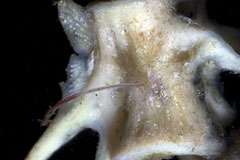Deep-sea worms eat found to eat fish bones

(PhysOrg.com) -- A new study led by a scientist at Scripps Institution of Oceanography at UC San Diego is painting a more complete picture of an extraordinary sea worm that makes its living in the depths of the ocean on the bones of dead animals.
Discovered fewer than 10 years ago off Monterey, Calif., but since identified in other oceans, the flower-like marine "boneworms," or Osedax, have been documented mainly living upon whale carcasses that fall to the ocean floor, leading some scientists to argue that Osedax specializes in whale bones. But Scripps Professor Greg Rouse, along with colleagues at Occidental College and Monterey Bay Aquarium Research Institute (MBARI) wondered: Do Osedax boneworms also live on the bones of non-mammals?
To assess the question, the researchers carried out an experiment, which is described in the April 13 online edition of Biology Letters, a Royal Society journal. The team employed MBARI's remotely operated vehicles Ventana and Doc Ricketts to deploy tuna and wahoo bones, as well as shark cartilage inside wire cages at approximately 1,000-meter (3,280-foot) depth off Monterey, Calif. When the researchers retrieved the cages five months later, they found Osedax living on the fish bones, although the shark cartilage had already been eaten by unknown organisms.
"We weren't sure that Osedax boneworms would be able to settle on fish bone and to grow to maturity and breed. When it actually turned out that we could establish all these things it was very satisfying," said Rouse. "That we actually found three different Osedax species living on the fish bones was a further bonus. The finding shows that Osedax boneworms are not whale bone specialists, but are arguably generalists and able to exploit a variety of vertebrate bones."
The finding also lends support to a hypothesis they have previously proposed that Osedax and its bone-eating lifestyle may have evolved millions of years ago during a time known as the Cretaceous period, well before the dawn of marine mammals.
"These bone-eating worms may have expanded their feeding niche several times to exploit the bones of large marine vertebrates as they successively colonized the world's oceans from land," say the authors in the paper.
The scientists say Osedax's ability to exploit non-mammalian bones could be an ancestral trait: "We suggest that whalebones are but one in a long series of food sources that Osedax has exploited and continues to exploit."
"Our experimental studies at MBARI have identified 17 species of Osedax from various depths in Monterey submarine canyon," said MBARI's Bob Vrijenhoek, a paper coauthor. "We now know that the worms are capable of subsisting on a variety of bones from cows, pigs and seals, but this new discovery of Osedax on fish bones forces us to take a fresh look at their nutritional limits and evolution."
The team now plans to further study the possible use of shark remains by Osedax and describe and further understand a host of new species of boneworms they have discovered off Monterey. They also plan to study how the worms actually eat into bone.
In addition to Rouse and Vrijenhoek, coauthors of the study include Shana Goffredi of Occidental College and Shannon Johnson of MBARI.
Provided by The Scripps Research Institute


















